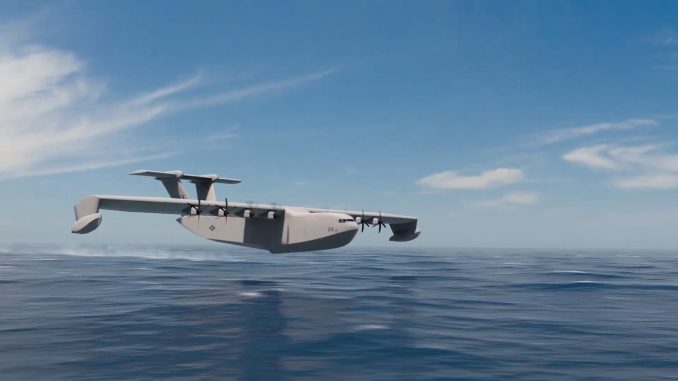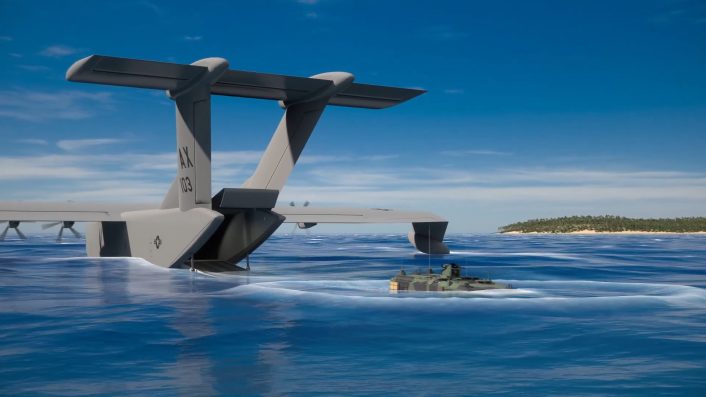
The video shows how Liberty Lifter can combine heavy-lift transport at the scale of a ship with the speed of an aircraft for fast logistics missions in a sea environment.
Aurora Flight Sciences, which is developing a Liberty Lifter Seaplane Wing-in-Ground Effect full-scale demonstrator for the Defense Advanced Research Projects Agency (DARPA), has released a video showing the intended concept of operations of its design. The company says the design has the benefit of combining transport at the scale of a ship with the speed of an aircraft, with a concept that can maximize efficiency by flying in ground effect and provide fast, heavy-lift transport that does not require an airstrip or shipping port.
The video starts by showing the vehicle flying in ground effect very close to the surface of the ocean, approaching its target. Then, after a water landing, the Liberty Lifter design gets close to the shore and open its rear ramp to unload amphibious vehicles begore quickly taking off again.
As we reported last year, DARPA started a program to create a long-range, low-cost X-Plane capable of seaborne strategic and tactical heavy lift, similar in size and capacity to the C-17 Globemaster III transport aircraft. Two teams, General Atomics working with Maritime Applied Physics Corporation and Aurora Flight Sciences working with Gibbs & Cox and ReconCraft, were initially selected, although the first team left the program after DARPA said it could not meet the project’s need “to create transformational change.”
The requirements set by DARPA say the aircraft needs to be able to takeoff and land in Sea State 4, operate efficiently at less than 100 feet above the surface for sustained on-water operation up to Sea State 5 (up to 13 ft wave height), fly out of ground effect at altitudes of up to 10,000 feet and transport huge payloads at speeds faster than current sea lift platforms. The ferry range required is greater than 6,500 nm, while the cargo capacity should be enough for two USMC Amphibious Combat Vehicles (ACV) or six twenty-foot container units.
Aurora’s design is similar to a traditional large seaplane or a flying boat aircraft, having a single hull, high-wing configuration, powered by eight turboprop engines, with a V-tail and floats at the wingtips. Earlier concept illustration showed wings that dropped downwards without floats on the wingtips and traditional tail.
The program
As part of Phase 1 of the program, Aurora Flight Sciences, a Boeing company, says it is designing a 213-ft wingspan demonstrator capable of carrying up to 50,000 lbs of cargo, making use of low-cost manufacturing techniques from the ship building industry to demonstrate affordability. In fact, Aurora has partnered with leading naval architecture and marine engineering company Gibbs & Cox, a Leidos company, on the project.
“Liberty Lifter fills a critical gap between today’s airlift and maritime transport capabilities,” said Mike Caimona, president and CEO of Aurora Flight Sciences. “Development in this space will advance strategic operations at sea, and we’re proud to be working with DARPA, Boeing, and our partners to move this technology forward.”
Phase1B of the program, which is now in progress, includes testing activities and concludes in a preliminary design review. According to the press release, tow tank testing has been completed in up to Sea State 4 at the Stevens Institute of Technology and Virginia Tech to develop and validate hydrodynamic models and seakeeping performance.
Propeller performance characterization testing was completed in preparation for wind tunnel testing of a scale model in early 2025, said Aurora. Additionally, the team is constructing a cockpit simulation lab for human-factors testing of pilot interaction with an advanced control system for flying in ground effect over high sea states.
The next phase of the program, Phase 2, includes continued development leading up to critical design review. Phase 3 of the program, projected to begin in 2026, includes manufacturing the demonstrator followed by flight testing starting in 2028.

What Are Wing-in-Ground Effect Vehicles?
The concept behind Liberty Lifter reminds the famous Ekranoplan, used by the Soviet and Russian navies in the 80s and 90s, also known a wing-in-ground effect vehicles. The Russian MD-160 Lun class ekranoplan, of which only one unit has been built, is a gigantic ground effect vehicle (GEV) designed in 1975, designed to attain sustained flight over a level surface (usually over the sea) by making use of ground effect, the aerodynamic interaction between the wings and the surface.
While there are some similarities, there are a couple of big differences between the Ekranoplan and Liberty Lifter. The first is that the Ekranoplan is classified as maritime ship by the International Maritime Organization due to its use of the ground effect and the inability to operate out of ground effect. The second difference is the role, as the Ekranoplan was designed for anti-surface warfare and equipped with six P-270 Moskit antiship missile launchers, while Liberty Lifter is being designed for cargo operations.
Wing-in-Ground Effect vehicles are a hybrid between airplanes and ships, able to move over water without actually touching it. In fact, they are able to move at high-speed over the water’s surface at a height of between one and five meters (three to 16 feet).
This aerodynamic principle is called the “ground effect.” The formation of wingtip vortices increases the efficiency of the wing. This effect, however, does not occur at high altitudes. This low-altitude flight ensures they are invisible to radars meant for aircraft. The water operation eliminates the need for docks or runways, while the payload capacity is greater than regular aircraft of the same size.
The proximity to the surface while flying makes them difficult to detect by radar. It is likely however that their ‘sea skimming’ might still not completely protect them from being detected, since large size makes for a big radar target, which might be visible to coastal radars.
